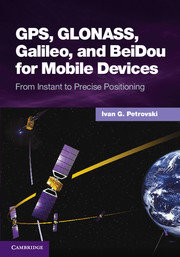Book contents
- Frontmatter
- Contents
- Foreword by Glen Gibbons
- About this book
- Acknowledgments
- List of abbreviations and acronyms
- List of definitions
- Part I GNSS: orbits, signals, and methods
- Part II From conventional to software GNSS receivers and back
- Part III Mobile positioning at present and in the future
- Part IV Testing mobile devices
- Index
Foreword by Glen Gibbons
Published online by Cambridge University Press: 05 May 2014
- Frontmatter
- Contents
- Foreword by Glen Gibbons
- About this book
- Acknowledgments
- List of abbreviations and acronyms
- List of definitions
- Part I GNSS: orbits, signals, and methods
- Part II From conventional to software GNSS receivers and back
- Part III Mobile positioning at present and in the future
- Part IV Testing mobile devices
- Index
Summary
Foreword by Glen Gibbons
The Law of Unintended Consequences – case in point: the mandate for enhanced 911(E911) services for mobile devices.
In 1996, the Federal Communications Commission (FCC), a US regulatory agency with broad powers over telecom providers and services, issued its first report, order, and notice of proposed rule-making (NPRM) regarding E911. The FCC action sought to require wireless telephone companies to be able to report automatically the location of an emergency caller.
This initiative proposed to bring to the rapidly expanding wireless space a requirement previously established for wireline providers. Unlike telephones at fixed locations, the whereabouts of a mobile phone was not readily known in emergencies, often not even to the callers themselves.
In issuing the NPRM, however, the Global Positioning System – let alone other GNSS systems – was not on the minds of the FCC commissioners. Indeed, if FCC staff and officials were aware of GPS in 1996, which had only reached full operational capability the year before, it was probably as the precise timing technology providing synchronization to wireline and some wireless networks.
No, in 1996, the FCC assumed that the positioning solutions for E911 would arise from within the networks themselves, using such techniques as angle of arrival (AOA), time of arrival (TOA), and time difference of arrival (TDOA).
- Type
- Chapter
- Information
- GPS, GLONASS, Galileo, and BeiDou for Mobile DevicesFrom Instant to Precise Positioning, pp. xiii - xviiiPublisher: Cambridge University PressPrint publication year: 2014

